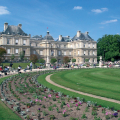JARDIN DU LUXEMBOURG
Go there and contact

Garden dominated by Mont Sainte-Geneviève, created by Jacques Boyceau at the request of Marie de Médicis, widow of Henri IV
Overlooked by Mont Sainte-Geneviève on land occupied by convents, colleges and mansions in the early 17th century, the garden stretches over 23 hectares between Odéon (north), the Latin Quarter (east), Port-Royal (south) and Boulevard Raspail (west). Nicknamed the "Luco", it owes its name to François de Luxembourg, an aristocrat from the French branch of the House of Luxembourg. It was created in 1612 by Jacques Boyceau at the request of Marie de Médicis, widow of Henri IV. Wishing to leave the Louvre, she had a residence worthy of her rank built, inspired by the Pitti Palace in Florence.
This first garden of 1612 was opened in front of the new palace, now the seat of the French Senate. Symmetrical parterres were laid out around a central fountain, which could soon be admired from a double ambulatory forming an Italian-style terrace. The compartmentalized plant compositions, laid out in the perspective of the palace, made for a typically French garden. But while the Luco belongs to the French tradition, its south-western section is laid out as an "English garden", recognizable by its irregular shapes, in contrast to the highly structured French style. It took no less than ten years to rebuild Arcueil's Roman aqueduct to supply the fountain.
In 1635, André Le Nôtre redesigned the parterres. Over time, the garden underwent a number of transformations and its area was reduced, notably to the northeast under the Second Empire, with the opening of Boulevard Saint-Michel and Rue de Médicis in accordance with Haussmann guidelines. In 1830, the garden was extended to include an orchard, greenhouses, an apiary (used as an apiary school) and an orangery, which houses Mediterranean plants and hosts temporary exhibitions in summer.
As you stroll down the aisles, you'll discover a wealth of statues, most of which date back to the Louis-Philippe period. Greek mythology, animals, French queens and other characters will accompany you as you stroll along. Don't miss the Médicis fountain, the Eugène Delacroix monument by Jules Dalou, the Musée du Luxembourg and the former Hôtel Vendôme now occupied by the Ecole des Mines de Paris. Chess enthusiasts will find regular tables, while plant lovers will be drawn to trees offering old varieties of pears, apples, etc. The keen eye may catch a glimpse of rare birds, owls or jackdaws. In short, a garden of elegance!
Did you know? This review was written by our professional authors.
The strengths of this establishment:
Members' reviews on JARDIN DU LUXEMBOURG
The ratings and reviews below reflect the subjective opinions of members and not the opinion of The Little Witty.


















A chaque fois que je viens à Paris, j'aime venir dans ce jardin et m'asseoir près de la fontaine central.